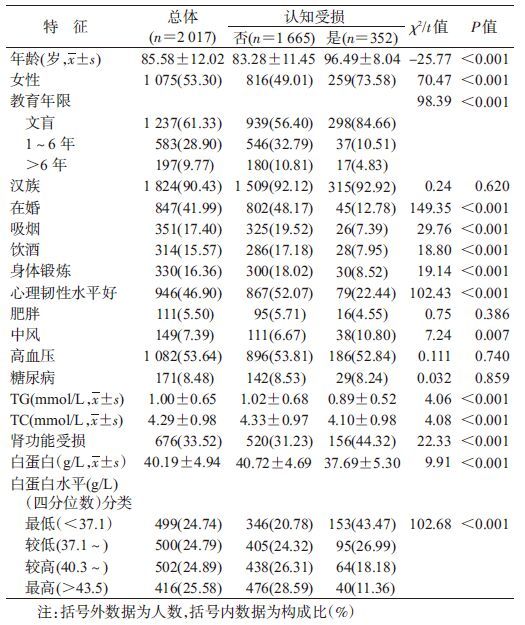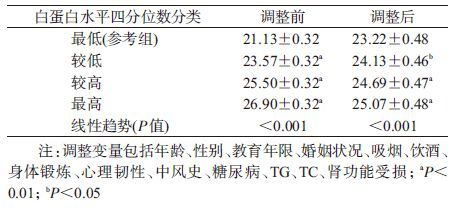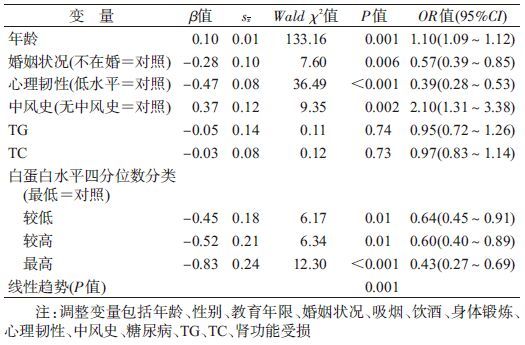文章信息
- 殷召雪, 王静雷, 吕跃斌, 罗杰斯, 曾毅, 施小明 .
- Yin Zhaoxue, Wang Jinglei, Lyu Yuebin, Luo Jiesi, Zeng Yi, Shi Xiaoming .
- 中国8个长寿地区65岁及以上老年人群血浆白蛋白水平与认知功能关系的研究
- Association between serum albumin and cognitive performance in elderly Chinese
- 中华流行病学杂志, 2016, 37(10): 1323-1326
- CHINESE JOURNAL OF EPIDEMIOLOGY, 2016, 37(10): 1323-1326
- http://dx.doi.org/10.3760/cma.j.issn.0254-6450.2016.10.001
-
文章历史
收稿日期: 2016-03-22
2. 100026 北京出入境检验检疫局;
3. 100871 北京大学国家发展研究院/健康老龄与发展研究中心;
4. 100021 北京, 中国疾病预防控制中心环境与健康相关产品安全所
2. Beijing Entry-exit Inspection and Quarantine Bureau, Beijing 100026, China;
3. Center for Study of Healthy Aging and Development Studies, National School of Development, Peking University, Beijing 100871, China;
4. Institute of Environmental Health and Related Product Safety, Chinese Center for Disease Control and Prevention, Beijing 100021, China
老年人群认知功能受损的影响因素很多,其中血液生物标志物是一类非常重要的因素,如血糖、血脂等[1]。近年来逐渐关注到血浆白蛋白水平与阿尔茨海默病和认知功能受损的关系,有研究认为 β-淀粉样蛋白沉积是阿尔茨海默病和认知受损发生发展的重要因素,而血浆白蛋白可与 β-淀粉样蛋白结合,是清除 β-淀粉样蛋白的重要调节因素[2]。此外,白蛋白还是人体非常重要的抗氧化剂,参与机体抗氧化系统[3],而氧化应激是机体认知功能受损的重要机制[4]。已有研究发现,通过血浆透析置换白蛋白可能是治疗轻度阿尔茨海默病具有前景的策略[5]。但目前血浆白蛋白与认知功能关系的人群流行病学研究较少[6-7],国内也仅有小样本的资料报道[8]。为此,本研究利用以社区人群为基础的中国老年健康影响因素跟踪调查(Chinese Longitudinal Health Longevity Survey,CLHLS)相关数据,探讨血浆白蛋白水平与老年人认知功能的关系。
对象与方法1. 研究对象: 源自CLHLS 中2012年在我国长寿地区开展的老年健康生物医学研究,调查对象包括山东莱州市、江苏如东县、河南夏邑县、湖北钟祥市、湖南麻阳县、广东佛山市三水区、广西永福县及海南澄迈县共8个长寿地区的所有百岁老年人以及随机匹配选取的90~99岁、80~89岁及65~79岁老年人。共调查≥65岁老年人2 354人,排除未测定血浆白蛋白者121人,认知功能评分缺失193人及教育程度数据缺失者23人,最终纳入本研究为2 017人。本研究经北京大学伦理委员会批准,所有调查对象均签署知情同意书。
2. 研究方法: 具体研究设计和方法见文献[9-10]。采用入户访谈收集调查对象一般人口学特征、吸烟/饮酒情况、身体活动情况和心理韧性水平,以及自报高血压、糖尿病和中风等患病情况。体格检查项目包括测量腰围、血压。采用国际上使用的简易认知功能量表(Mini Mental State Evaluation,MMSE)测定认知功能,该量表可测定定位、识别、计算能力、记忆能力及语言能力[11],总分30分,得分越高认知功能越好。采集空腹静脉抗凝血分离血浆后置低温运输箱运至首都医科大学临床检验中心,对所有样品集中统一检测。利用商业诊断试剂盒(罗氏诊断,德国)在自动生化仪(Hitachi 7180,日本)上分别采用免疫比浊法、甘油磷酸氧化酶-过氧化物酶法、胆固醇氧化酶法、葡萄糖氧化酶法、苦味酸比色法、脲酶紫外速率法和溴甲酚绿法测定血浆白蛋白、TC、TG、FPG、血肌酐、血尿素氮及超敏C-反应蛋白。此外还在研究现场利用全血样本分析调查对象的血红蛋白水平。
3. 相关指标定义和诊断标准:由于教育程度是认知功能重要的影响因素,本研究采用基于教育程度的认知受损的评定标准[12],即未受过教育者认知受损标准为 MMSE<18,接受教育1~6年者认知受损标准为MMSE<20,接受教育≥6年者为MMSE<24,否则定义为认知正常。通过量表测定研究对象的心理韧性[13],得分越高其心理韧性越好,本研究将≥16分者定义为心理韧性好。通过问题“您现在吸烟吗?”来判定研究对象当前吸烟状况,按照回答“是”或者“否”分为吸烟、不吸烟;通过问题“您现在常喝酒吗?”判定研究对象的饮酒状况,并分为饮酒、不饮酒[13]。SBP≥140 mmHg(1 mmHg=0.133 kPa)或DBP≥90 mmHg或报告已诊断高血压者定义为高血压。FPG≥7.0 mmol/L或报告已诊断为糖尿病者定义为糖尿病[14-15]。BMI≥28 kg/m2定义为肥胖[16]。将肾小球滤过率<60 ml·min-1·1.73 m2(-1)定义为肾功能受损[17]。
4. 统计学分析:按照认知功能评估分为认知正常组和认知受损组。按照白蛋白水平的四分位数将研究对象分为最低、较低、较高和最高4组。通过t检验(针对连续变量)或 χ2检验(针对分类变量)比较两组基本状况。利用广义线性模型分析两组比较差异有统计学意义的变量。分析不同白蛋白水平的研究对象MMSE评分及其趋势。利用多因素logistic回归模型,以认知受损为因变量,调整进入广义线性模型的变量,采用后退法,将混杂变量TG和TC保留在模型中,分析血浆白蛋白水平与认知受损的关系。将白蛋白水平按分类变量(最低、较低、较高和最高)设置哑变量后纳入模型分析。采用SAS 9.2软件分析数据,以P<0.05为差异有统计学意义。
结果1. 基本特征:与认知正常组相比,认知受损组年龄更大,女性比例大,在婚状态比例低;不吸烟、不饮酒及身体锻炼和心理韧性水平较好者的比例较低,中风的自我报告率高; TG和TC水平低,肾功能受损者较多,白蛋白水平较低,白蛋白水平最低者所占的比例也较高(表 1)。
2. 不同血浆白蛋白水平的MMSE评分:采用广义线性模型分析显示,调整相关变量后,随着白蛋白水平的升高,MMSE评分从最低组的23.22分升至最高组的25.07分,且呈线性升高趋势(P<0.001)。与白蛋白水平最低组相比,其他各组的MMSE的评分较高(P<0.01)。见表 2。
3. 血浆白蛋白水平与认知受损的关系:通过logistic回归模型分析,与白蛋白最低四分位水平组相比,调整人口学特征变量及行为生活方式和健康状况等协变量,白蛋白水平较低组、较高组和最高组的认知受损风险均较低,差异有统计学意义(P<0.01),OR值(95%CI)分别为0.64(0.45~0.91)、0.60 (0.40~0.89)和0.43(0.27~0.69),并具有线性趋势(P=0.01)。见表 3。
4. 血浆白蛋白与血红蛋白、超敏C-反应蛋白水平的相关性:相关分析发现,白蛋白与血红蛋白水平显著正相关(r=0.21,P<0.000 1),与超敏C-反应蛋白呈显著负相关(r=-0.13,P<0.000 1)。
讨论本研究表明老年人血浆白蛋白水平与MMSE评分之间呈现正向线性趋势,并与认知受损风险反向相关,亦呈线性趋势。结果与其他横断面研究报道一致[6, 8, 18-19]。表明老年人认知受损与较低的白蛋白水平相关。此外,相关病例对照研究也显示,老年痴呆患者体内血浆白蛋白水平较低[7];近年的队列研究也提示较低的血浆白蛋白水平与认知功能受损发生风险显著相关[20]。
究其原因,本研究认为有以下几个可能的解释。首先,血浆白蛋白是清除 β-淀粉样蛋白的重要调节因素[21],而后者又是老年痴呆发生发展的关键因素[22]。血浆白蛋白可与血浆中90%~95%的β-淀粉样蛋白结合,由于脑脊液中白蛋白水平较低[21, 23],如血浆白蛋白浓度降低,减少与β-淀粉样蛋白结合,导致血液中 β-淀粉样蛋白水平升高,进而导致脑脊液中 β-淀粉样蛋白水平升高,而且血浆白蛋白水平降低还会引起淀粉样蛋白纤维的生成增多[21],从而导致认知障碍的风险增加。其次,白蛋白还是一种重要的抗氧化剂,其特有的化学结构使白蛋白能够清除自由基,氧化自身从而保护细胞膜、DNA等重要的细胞结构[2],降低氧化应激水平,从而保护认知功能[4]。此外白蛋白水平还可能是影响认知功能的间接指标,如可反映机体营养状况和慢性炎症水平[19, 24]。本研究也发现白蛋白水平与血红蛋白水平呈正相关(P<0.000 1),与超敏C-反应蛋白呈显著负相关(P<0.000 1)。而超敏C-反应蛋白参与机体慢性炎症反应机制,且后者又是认知受损和痴呆发生的重要因素[25-26]。但也有不同观点,如Dik等[19]在排除认知受损者后,白蛋白水平与MMSE 之间的关系不再显著,其中原因仍需进一步研究。
本文为横断面研究,无法确定白蛋白水平与认知功能两者之间的因果关系;此外研究中尽管已调整了多个指标,但某些可能影响认知功能的遗传因素未能纳入模型分析。
| [1] | Yin ZX, Shi XM, Kraus VB, et al. High normal plasma triglycerides are associated with preserved cognitive function in Chinese oldest-old[J]. Age Ageing , 2012, 41 (5) : 600–606 DOI:10.1093/ageing/afs033 |
| [2] | Algamal M, Milojevic J, Jafari N, et al. Mapping the interactions between the Alzheimer's A β-peptide and human serum albumin beyond domain resolution[J]. Biophys J , 2013, 105 (7) : 1700–1709 DOI:10.1016/j.bpj.2013.08.025 |
| [3] | Sitar ME, Aydin S, Cakatay U. Human serum albumin and its relation with oxidative stress[J]. Clin Lab , 2013, 59 (9/10) : 945–952 DOI:10.7754/Clin.Lab.2012.121115 |
| [4] | Revel F, Gilbert T, Roche S, et al. Influence of oxidative stress biomarkers on cognitive decline[J]. J Alzheimers Dis , 2015, 45 (2) : 553–560 DOI:10.3233/JAD-141797 |
| [5] | Boada M, Ortiz P, Anaya F, et al. Amyloid-targeted therapeutics in Alzheimer's disease:use of human albumin in plasma exchange as a novel approach for aβ mobilization[J]. Drug News Perspect , 2009, 22 (6) : 325–339 DOI:10.1358/dnp.2009.22.6.1395256 |
| [6] | Kim TS, Pae CU, Yoon SJ, et al. Decreased plasma antioxidants in patients with Alzheimer's disease[J]. Int J Geriatr Psychiatry , 2006, 21 (4) : 344–348 DOI:10.1002/gps.1469 |
| [7] | Ng TP, Feng L, Niti M, et al. Albumin,haemoglobin,BMI and cognitive performance in older adults[J]. Age Ageing , 2008, 37 (4) : 423–429 DOI:10.1093/ageing/afn102 |
| [8] | 陈晋文, 陈大伟, 杜文津, 等. 血清白蛋白水平与老年人认知功能的关系[J]. 中国老年学杂志 , 2013, 33 (14) : 3487–3488 DOI:10.3969/j.issn.1005-9202.2013.14.117 Chen JW, Chen DW, Du WJ, et al. Association of serum albumin and cognitive function in the elderly[J]. Chin J Gerontol , 2013, 33 (14) : 3487–3488 DOI:10.3969/j.issn.1005-9202.2013.14.117 |
| [9] | Zeng Y. Toward deeper research and better policy for healthy aging-using the unique data of Chinese Longitudinal Healthy Longevity Survey[J]. Chin Economic J , 2012, 5 (2/3) : 131–149 DOI:10.1080/17538963.2013.764677 |
| [10] | 吕跃斌, 殷召雪, 罗杰斯, 等. 中国长寿地区高龄老年人贫血及其3年死亡风险关系的研究[J]. 中华流行病学杂志 , 2015, 36 (7) : 682–686 DOI:10.3760/cma.j.issn.0254-6450.2015.07.004 Lyu YB, Yin ZX, Luo JS, et al. Association between anemia and 3-year all-cause mortality among oldest old people in longevity areas in China[J]. Chin J Epidemiol , 2015, 36 (7) : 682–686 DOI:10.3760/cma.j.issn.0254-6450.2015.07.004 |
| [11] | Folstein MF, Folstein SE, McHugh PR. "Mini-mental state". A practical method for grading the cognitive state of patients for the clinician[J]. J Psychiatr Res , 1975, 12 (3) : 189–198 DOI:10.1016/0022-3956(75)90026-6 |
| [12] | Cui GH, Yao YH, Xu RF, et al. Cognitive impairment using education-based cutoff points for CMMSE scores in elderly Chinese people of agricultural and rural Shanghai China[J]. Acta Neurol Scand , 2011, 124 (6) : 361–367 DOI:10.1111/j.1600-0404.2010.01484.x |
| [13] | Yin ZX, Shi XM, Kraus VB, et al. Gender-dependent association of body mass index and waist circumference with disability in the Chinese oldest old[J]. Obesity , 2014, 22 (8) : 1918–1925 DOI:10.1002/oby.20775 |
| [14] | 殷召雪, 施小明, 徐建伟, 等. 高龄老人高敏C反应蛋白与糖尿病的关系[J]. 中国糖尿病杂志 , 2012, 20 (5) : 332–335 DOI:10.3969/j.issn.1006-6187.2012.05.004 Yin ZX, Shi XM, Xu JW, et al. Association between the hypersensitive C-reactive protein and diabetes in the senile elders[J]. Chin J Diabetes , 2012, 20 (5) : 332–335 DOI:10.3969/j.issn.1006-6187.2012.05.004 |
| [15] | Chei CL, Raman P, Ching CK, et al. Prevalence and risk factors of atrial fibrillation in Chinese elderly:results from the Chinese Longitudinal Healthy Longevity Survey[J]. Chin Med J , 2015, 128 (18) : 2426–2432 DOI:10.4103/0366-6999.164918 |
| [16] | 王醴湘, 吕筠, 郭彧, 等. 中国慢性病前瞻性研究:10个项目地区成年人超重/肥胖现况分析[J]. 中华流行病学杂志 , 2015, 36 (11) : 1190–1194 DOI:10.3760/cma.j.issn.0254-6450.2015.11.002 Wang LX, Lyu J, Guo Y, et al. Regional specific differences in prevalence of overweight/obesity in China:findings from China Kadoorie Biobank study in 10 areas in China[J]. Chin J Epidemiol , 2015, 36 (11) : 1190–1194 DOI:10.3760/cma.j.issn.0254-6450.2015.11.002 |
| [17] | Darsie B, Shlipak MG, Sarnak MJ, et al. Kidney function and cognitive health in older adults:the Cardiovascular Health Study[J]. Am J Epidemiol , 2014, 180 (1) : 68–75 DOI:10.1093/aje/kwu102 |
| [18] | Llewellyn DJ, Langa KM, Friedland RP, et al. Serum albumin concentration and cognitive impairment[J]. Curr Alzheimer Res , 2010, 7 (1) : 91–96 DOI:10.2174/156720510790274392 |
| [19] | Dik MG, Jonker C, Hack CE, et al. Serum inflammatory proteins and cognitive decline in older persons[J]. Neurology , 2005, 64 (8) : 1371–1377 DOI:10.1212/01.wnl.0000158281.08946.68 |
| [20] | Taniguchi Y, Shinkai S, Nishi M, et al. Nutritional biomarkers and subsequent cognitive decline among community-dwelling older Japanese:a prospective study[J]. J Gerontol A BiolSci Med Sci , 2014, 69 (10) : 1276–1283 DOI:10.1093/gerona/glt286 |
| [21] | Stanyon HF, Viles JH. Human serum albumin can regulate amyloid-β peptide fiber growth in the brain interstitium:implications for Alzheimer disease[J]. J Biol Chem , 2012, 287 (33) : 28163–28168 DOI:10.1074/jbc.C112.360800 |
| [22] | Stevens RW, Elmendorf D, Gourlay M, et al. Application of fluoroimmunoassay to cerebrospinal fluid immunoglobulin G and albumin[J]. J Clin Microbiol , 1979, 10 (3) : 346–350 |
| [23] | Mackic JB, Weiss MH, Miao W, et al. Cerebrovascular accumulation and increased blood-brain barrier permeability to circulating Alzheimer's amyloid β peptide in aged squirrel monkey with cerebral amyloid angiopathy[J]. J Neurochem , 1998, 70 (1) : 210–215 DOI:10.1046/j.1471-4159.1998.70010210.x |
| [24] | Gabay C, Kushner I. Acute-phase proteins and other systemic responses to inflammation[J]. N Engl J Med , 1999, 340 (6) : 448–454 DOI:10.1056/nejm199902113400607 |
| [25] | Wichmann MA, Cruickshanks KJ, Carlsson CM, et al. Long-term systemic inflammation and cognitive impairment in a population-based cohort[J]. J Am Geriatr Soc , 2014, 62 (9) : 1683–1691 DOI:10.1111/jgs.12994 |
| [26] | Eikelenboom P, Hoozemans JJM, Veerhuis R, et al. Whether,when andhow chronic inflammation increases the risk of developing late-onset Alzheimer's disease[J]. Alzheimers Res Ther , 2012, 4 (3) : 15 DOI:10.1186/alzrt118 |
 2016, Vol. 37
2016, Vol. 37





